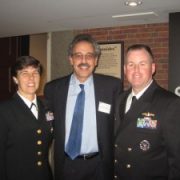“De-aging” George Washington
Special note: This story has been condensed and reprinted from the Summer 2006 edition of The Affiliate newsletter. Part of our Seriously Amazing Affiliates blog series.
 Mount Vernon Estate and Gardens has preserved the home of George Washington for more than 150 years, always striving to present the most current and well-researched scholarship about our nation’s first president. In 2006, the Donald W. Reynolds Museum and Education Center opened at Mount Vernon, featuring three life-size mannequins of Washington, created, in part, through a unique collaboration between Mount Vernon, a Smithsonian Affiliate; several Smithsonian experts; and the National Museum of Dentistry, also an Affiliate.
Mount Vernon Estate and Gardens has preserved the home of George Washington for more than 150 years, always striving to present the most current and well-researched scholarship about our nation’s first president. In 2006, the Donald W. Reynolds Museum and Education Center opened at Mount Vernon, featuring three life-size mannequins of Washington, created, in part, through a unique collaboration between Mount Vernon, a Smithsonian Affiliate; several Smithsonian experts; and the National Museum of Dentistry, also an Affiliate.
Jeffrey Schwartz, physical anthropologist and professor at the University of Pittsburgh, led the two-year effort. Using his knowledge of teeth and bone structure, Schwartz examined the existing evidence for clues about George Washington’s appearance at different times in his life. Aiding him in this forensic reconstruction was the Partnership for Research in Spatial Modeling (PRISM), a laboratory at Arizona State University that specializes in 3-D digital imaging.

3-D computer generated images are a result of scanning Washington’s life mask and portrait bust. Photo courtesy of Mount Vernon Ladies Association.
Mount Vernon identified the many relics of Washington’s life that could provide necessary information. Using a computerized digital scanner, Schwartz scanned a 1785 life mask owned by the Morgan Library & Museum, a Jean-Antoine Houdon bust at the Corcoran Gallery of Art and a full body Houdon sculpture in the Virginia State Capitol Rotunda. Many of the Washington objects owned by the Smithsonian were also scanned or examined by Schwartz and his team.
One of the biggest challenges was determining what Washington looked like as a young man as no portraits depict his image before the age of 40. To help, the National Portrait Gallery provided insight into the many portraits of Washington, as well as into the conventions of 18th century portraiture.
Washington’s dentures played a vital role in reconstructing Washington’s face. As he lost teeth and bone in his jaw, the shape of his face changed. Dentures also change the jaw line depending on how they fit in the mouth. By examining the dentures that Washington used in his lifetime, the team was able to create a timeline that identified the progression of Washington’s tooth loss. As the mannequins depict Washington at the ages of 19, 45 and 57, this timeline provided critical information on the changing shape of Washington’s face.
Three versions of Washington’s dentures can be found at the National Museum of Dentistry in Baltimore, Maryland. One is an original, complete denture for the lower jaw dated 1795, while the other two are replicas of dentures in other collections.
Since 18th century portraits emphasized the sitter’s face and not the body, information on Washington’s build was extracted from his clothing. By taking volumetric measurements of his trousers, waistcoats and shirts, clues to Washington’s height (6’ 2”) and build could be extrapolated.
The National Museum of American History gave the team access to Washington’s military uniform which provided the prototype for the costume to be worn by the 45-year-old mannequin depicting Washington at Valley Forge.
After consulting with these experts, the scans and measurements were fed into a special computer program that produced three-dimensional images of Washington. Eventually, the images were printed out or “milled” on a special machine into high-density foam, and the mannequins became reality.






















